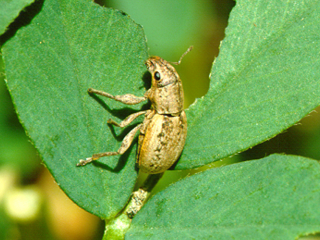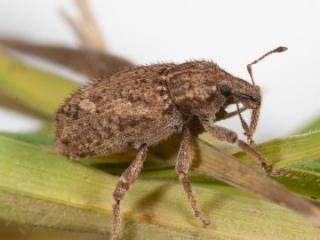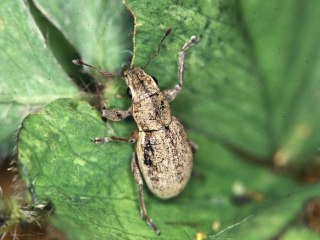Identifying and managing weevils in canola
- Green Range
- Ravensthorpe
James Bee (Elders) has reported that small lucerne weevil are causing damage to canola near Green Range. The canola plants range from the cotyledon to one true leaf stage. The canola had been sown into a lucerne and chicory pasture. A post-sowing pre-emergent spray of Pyrinex Super was applied.
A grower near Ravensthorpe has found high numbers of small lucerne weevil in a lucerne paddock that has been sprayed with alpha-cypermethrin. Live and dead weevils were still found after the application of insecticide. In this case, the paddock will be sown into a cereal rather than canola.
Three species of weevils typically damage canola: vegetable weevil, desiantha (spotted vegetable) weevil, and small lucerne weevil.
Identifying canola weevils
Vegetable weevils are about 10mm long with two short white stripes at an angle on each side of its abdomen. They prefer broadleaved plants, especially capeweed. They are often camouflaged amongst stubble and trash and tend to hide during the day.
Desiantha weevil adults are mottled grey-black in colour with grey flecks on the abdomen, and have the typical elongated weevil snout. They grow up to 7mm long and are flightless. Larvae are white, legless grubs with orange-brown heads, and grow to 8mm in length. Adults chew cotyledons, leaves and stems of canola plants, and may eat small plants down to ground level.
Small lucerne weevil adults are about 5mm long, light grey in colour with a white stripe on each side. Small lucerne weevil will hide under stubble and may not come into contact with insecticides. After spraying check for new damage in crops or for live beetles before seeding.
Adult vegetable weevils often harbour in rock heaps and remnant bush areas, and move into the adjoining canola crop from these refuges. The other two weevils have been known to cause damage across the whole paddock.
Weevils can be very hard to find as they hide and play dead with their legs tucked, which helps them blend in with their surroundings. Pitfall traps placed into the ground can be an effective way to find weevils.
If you are unsure of the type of weevil you have found in your canola crop use the PestFax Reporter app (new version to be released soon) to request an identification by our entomologists.
Diagnosing weevil damage
Weevils chew off parts of leaves and cotyledons, giving them a serrated appearance and can eat plants down to ground level at high numbers.
Sometimes crop damage is restricted to paddock edges or where capeweed was in abundance the previous year.
Managing canola weevils
Weevils can be a frustrating pest as they can survive spray applications of insecticides at registered rates due to their behaviour of hiding during the day. For this reason, it can be more effective to spray in the evening when weevils are active.
For insecticide recommendations on managing vegetable weevils in canola, refer to DPIRD’s 2022 autumn winter insecticide spray guide. The vegetable weevil requires higher rates of insecticides than most pests of canola.
For more information on weevils visit DPIRD's Diagnosing weevils in canola page.
For more information contact Research scientist Svetlana Micic, Albany on +61 (0)8 9892 8591.
Article authors: Cindy Webster (DPIRD Narrogin) and Svetlana Micic (DPIRD Albany).



